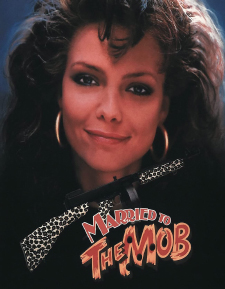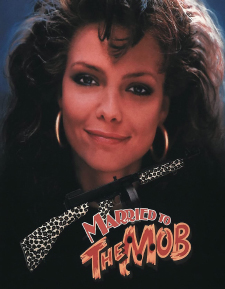Married to the Mob (Blu-ray Review)

Director
Jonathan DemmeRelease Date(s)
1988 (October 25, 2022)Studio(s)
Orion Pictures/MGM (Fun City Editions/Vinegar Syndrome)- Film/Program Grade: B+
- Video Grade: B
- Audio Grade: B+
- Extras Grade: B
Review
“God, you people work just like the mob! There's no difference.”
“Oh, there's a big difference, Mrs. de Marco. The mob is run by murdering, thieving, lying, cheating psychopaths. We work for the President of the United States of America.”
Director Jonathan Demme was on a roll in the Eighties, after kicking off the decade with his Oscar-nominated Melvin and Howard. He did have one major storm cloud in the form a lead actor with a vision of her own for Swing Shift in 1983, but after that unfortunate experience, he defiantly forged his own idiosyncratic path. He reinvigorated the concert film with both Stop Making Sense and Swimming to Cambodia, and also reinvented the screwball comedy with Something Wild. After that, he closed out the decade by making a romantic comedy of a different sort with Married to the Mob, which remains one of his breeziest and most effervescent films. The lighter tone and almost cartoonish style meant that it didn’t quite become the critical darling that Something Wild had, but it’s far too impeccably well-crated to be dismissed as one of his “lesser” efforts. It’s indisputably Demme’s own distinctive vision, filtered through the lens of all of his collaborators on the project.
Married to the Mob started out as a screenplay by Barry Strugatz and Mark Burns, who centered their story around Angela (Michelle Pfeiffer), a suburban housewife who just happens to be married to “Cucumber” Frank de Marco (Alec Baldwin), a man who works as an enforcer for the mob. A series of events leads her to try to escape the life and start a new one of her own, but the mob boss Tony “The Tiger” Russo (Dean Stockwell) is on her heels, and Tony’s wife Connie (Mercedes Ruehl, a tiger of her own) is after both of them. Meanwhile, she’s become the target of an FBI investigation led by Mike Downey (Matthew Modine), who unintentionally becomes an important part of her attempt to create a new life for herself.
The script from Strugatz and Burns was the recipe, but turning that formula into the confection that is Married to the Mob took a legion of cast and crew members, all under the guidance of Demme as the master chef. He brought his trusted collaborators on board, like cinematographer Tak Fujimoto, production designer Kristi Zea, and costume designer Collen Atwood. (Married to the Mob was actually Atwood’s first film with Demme, but it wouldn’t be her last.) They all helped to bring the perfect pastel-fueled tone to the film—even title designer Pablo Ferro made an invaluable contribution in that regard. Demme brought in Talking Heads frontperson David Byrne to write the score, and also added his trademarked eclectic mix of songs for the soundtrack, in this case featuring Rosemary Clooney, New Order, Sinead O'Connor, Chris Isaak, The Pixies, Tom Tom Club, The Feelies, Debby Harry, Brian Eno, Ziggy Marley, and much more.
Demme’s gift for casting is also on full display in Married to the Mob. The supporting cast is superb, including Trey Wilson, Oliver Platt, Joan Cusack, O-Lan Jones, and Nancy Travis. He also featured plenty of his stock company, like Charles Napier, producer Kenneth Utt, Tracey Walter, Paul Lazar, Joe Spinell, and Sister Carol East, plus cameos from a diverse group that included Chris Isaak, Jake Johansen, Al Lewis, Colin Quinn, and Todd Solondz. Yet the film still belongs to its leads. Mercedes Ruehl owns the film with her scene-stealing performance—there’s a direct line from her work in Married to the Mob to her Oscar-winning performance in The Fisher King. Still, a romantic comedy like this couldn’t work without a plausible love story at its core, so Pfeiffer and Modine are the real key to holding all of the diverse ingredients together. They have genuine chemistry, and share some legitimately touching scenes together. Married to the Mob is a film about second chances, so both characters are given the opportunity to make their mistakes, accept the consequences for them, and then put everything behind them. It's a sweet-natured heart to a film that could have felt much more trivial in lesser hands, but Demme, Pfeiffer, and Modine were up to the task.
All that, plus a particularly memorable closing credit sequence. Demme had to cut the film down to a reasonable length for theatrical release, but he didn’t want to lose all of the footage that he shot, so he included a montage of outtakes at the conclusion. The film definitely flows better without any of it, but it’s still nice to see a few things fleshed out more than they were in the final cut. (Watch to the very end for a blooper that could have had tragic results if Modine didn’t have very quick reflexes.) Also, Married to the Mob has one of the single best credits ever: “Valet-Matic and Cat-O-Matic designed by Nancy Howard and Joe Smith.” You’ll just have to see the film for yourself to understand that one.
Tak Fujimoto shot Married to the Mob on 35 mm film using Arriflex cameras with spherical lenses, framed at 1.85:1 for its theatrical release. This version uses a new 2K scan of the original interpositive, and compared to the 2014 Kino Lorber Blu-ray, the results are a bit of a mixed bag. This one is much cleaner, with less of the speckling and other minor damage that was visible on the Kino disc. The color palette is also slightly richer, though not dramatically so; for example, the reds in the club where Nancy Travis works are a bit more vivid in this version. On the other hand, there appears to have been some sharpening applied, and that interferes with the grain patterns at times, giving them a noisy look. There’s also a bit of aliasing during the opening credits now, although for some reason it only affects the blue titles, not the white or yellow ones—strangely enough, when both white and blue titles appear in the same frame, only the blues are affected. (It almost looks like dot crawl, which is an old artifact from the composite analogue video days, so it shouldn’t be anything related to that.) The blacks can appear a little washed out in night shots, too. Overall, this new master still has a slight edge over the older Kino disc when seen from normal viewing distances—it’s only when viewed at closer ranges that the deficiencies really stand out.
Audio is offered in English 2.0 LPCM, with optional English subtitles. Married to the Mob was released theatrically in Dolby SR, so this is a four-channel mix matrixed into two. It’s a fairly restrained mix, with the surrounds mostly providing ambient effects such as crowd noises. As an Eighties Jonathan Demme film, it’s the music that’s the star of the show, and both the songs and the score from David Byrne sound wonderful as presented here. Everything is clean and free of distortion. (Kino’s disc offered the same 2.0 track in DTS-HD Master Audio instead, and there’s no practical difference between the two.)
The Fun City Editions Blu-ray release of Married to the Mob includes a reversible insert that spotlights the artwork from three different theatrical posters—one on the front, two on the reverse—as well as a 16-page booklet with essays by Jourdain Searles and Margaret Barton-Fumo. There was a slipcover available directly from Vinegar Syndrome, limited to the first 2,000 units, but it’s already sold out. The following extras are included, all of them in HD:
- Audio Commentary with Millie De Chirico and Danielle Henderson
- Writing Married to the Mob (32:10)
- It Barreled Into My Life (28:53)
- A Simple Enjoyment of Life (21:43)
- Theatrical Trailer (2:09)
- Image Gallery (4:43)
The commentary features Mille De Chirico and Danielle Henderson of the I Saw What You Did podcast. It’s more of an appreciation from a fan’s perspective than an actual commentary—there’s not much in the way of facts or analysis, just a lot of pointing out things that they like about the film. There are also a lot of pauses while they just watch the film and laugh at it. They do note a few interesting details, like some of the more obscure cameos, but it’s a pretty lightweight commentary overall.
Writing Married to the Mob is an interview with screenwriters Barry Strugatz and Mark Burns, who open by talking about how they met in film school, and then they explain the development of the script. They drew inspiration from a variety of sources, including Hitchcock’s Notorious, and they even attended one of John Gotti’s trials as research. They have plenty of praise the cast and crew of the film, noting the deft way that Demme balanced the violence with the comedy, and they also loved how Michelle Pfeiffer brought Angela de Marco to life. It Barreled Into My Life is an interview with the irrepressible Mercedes Ruehl, who explains how she was worried about being typecast, so she didn’t want Connie to be a caricature. She wanted to play her as a real human being who’s been hurt, and fortunately that’s exactly what Demme wanted as well. Ruehl also relates her fond memories of the director, who she says was always respectful toward each and every person on the set. Finally, A Simple Enjoyment of Life is an interview with Matthew Modine, who still isn’t sure what exactly what Demme saw in him, but he enjoyed the experience. He describes Married to the Mob as having the most collaborative set that he’s ever been on, since Demme was open to ideas from everyone. That openness extended to Modine himself, who is proud of the fact that Demme listened to him to change a key scene for the better. Perhaps most importantly for fans of the film, Modine also finally tells the story of exactly what happened with Michelle Pfeiffer in the outtake of them dancing on the steps.
Married to the Mob has never had the critical cachet that Something Wild generated, which is clearly demonstrated by the fact that the latter got a Criterion Collection release, while Married to the Mob previously had to settle for a bare-bones version from Kino Lorber. Fortunately, Fun City Editions has rectified that situation here with a nice set of extras and a more attractive package design. It’s a nifty set for existing fans of the film, but hopefully it also opens the door to bring some new fans into the fold.
- Stephen Bjork
(You can follow Stephen on social media at these links: Twitter and Facebook.)

